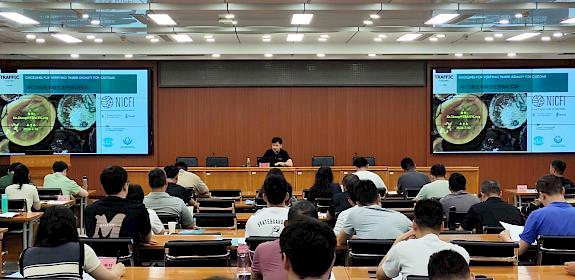Russia Tiger habitat gets a boost with protection of key tree species
Moscow, Russia, 29th July 2010, World Tiger Day—the Russian government has introduced measures to protect the Korean Pine, a key species found in Amur Tiger habitat in the Russian Far East.

Rising global demand for Korean Pine has led to a massive increase in logging, much of it carried out illegally, in Russia’s remaining temperate forests.
To help regulate the logging, Russia has listed the Korean Pine in Appendix III of CITES (the Convention on International Trade in Endangered Species of Wild Fauna and Flora).
The listing means exports of Korean Pine timber from Russia will need CITES permits, which will make it harder for the illegal timber trade to carry on.
“TRAFFIC and WWF Russia warmly welcome the measures to regulate the trade in Korean Pine timber, which is good news for the local people whose livelihoods depend on the trade in Korean Pine nuts and for Amur Tigers which live where these trees grow,” said Alexey Vaisman, Senior Programme Officer with TRAFFIC Europe-Russia.
“The new measures will need to be backed up with appropriate enforcement action,” added Vaisman.
Analysis of export data show the commercial trade in Korean pine timber rising over the last decade, in spite the global economic downturn which has reduced trade in most timber species.
The new measures will benefit the legal pine nut trade in the region which WWF and TRAFFIC have been promoting as a means of providing legal and sustainable income.
“We hope the listing in CITES will finally help break the system of illegal logging of Korean Pines and help the survival of trade in alternative, sustainable forestry products from the region,” said Evgeny Lepeshkin, Forestry Projects Co-ordinator with the Amur branch of WWF Russia.
The recently introduced measures come in the midst of a particularly active year for tiger conservation.
Around 400 Amur Tigers survive in the native Korean Pine forests of the Russian Far East and north-east China, where the pine nuts are an essential food source for Tiger prey species.
“The fate of the Amur Tiger is inextricably linked to the safeguard of the Korean Pine,” said Pauline Verheij, joint TRAFFIC and WWF Tiger Trade Programme Manager.
On 14 July, the 13 countries with surviving Tiger populations drafted an historic Declaration on Tiger Conservation.
The Declaration commits the countries to double the number of remaining wild Tigers, whose population currently stands at 3,200, by 2022.
Russia will host a Heads of Government Tiger Summit later this year where it is anticipated the Declaration will be formally signed.
“Russia is putting in place the kind of measures that will help with the commitment by Tiger range countries to double numbers of wild Tigers by 2020,” said Verheij.
Notes:
29th July was designated World Tiger Day by high level government officials of the 13 Tiger range countries, who met in Hua Hin, Thailand, last January.
A number of Tiger-related events will be taking place on World Tiger Day and there will be WWF participation in a Tiger conservation rally and three-day mass awareness event in Kathmandu, Nepal, and a “Freeze Tiger Trade” event organized by WWF Malaysia in Kuala Lumpur.
2010 is Chinese Year of the Tiger. The next Year of the Tiger will be in 2022.



